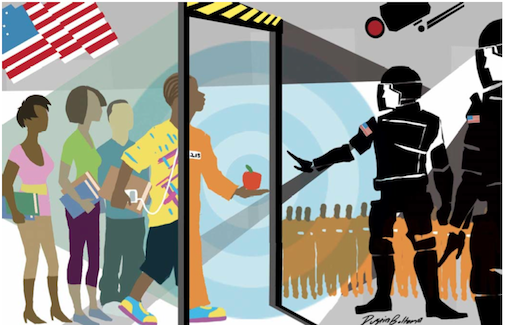LatinaLista — Two headlines that have dominated the news in the last few months when it comes to our public schools are: Latino and Black children are now the “majority-minority” and students of color are among those targeted for school suspensions.
Along with these headlines, we know that those schools that service a primarily minority, low-income student body usually suffer from disrepair, inadequate textbooks and school supplies and inexperienced teachers.
However, a new report from the U.S. Department of Education Office for Civil Rights highlights several other factoids that begs the question: Is our public education system purposely setting up a school-to-prison pipeline for minority students and children classified as disabled?
According to the report:
- Black children represent 19% of preschool enrollment, but 47% of preschool children receiving one or more out-of-school suspensions; in comparison, white children represent 41% of preschool enrollment, but 28% of preschool children receiving one or more out-of-school suspensions.
- Racial disparities in suspensions are also apparent in K-12 schools: While 6% of all K-12 students received one or more out-of-school suspensions, the percentage is 18% for black boys; 10% for black girls; 5% for white boys; and 2% for white girls.
- American Indian or Alaska Native, Latino, Native Hawaiian or other Pacific Islander, and multiracial boys are also disproportionately suspended from school, representing 15% of K-12 students but 19% of K-12 students receiving one or more out-of-school suspensions.
- Students with disabilities in grades K-12 are disproportionately suspended from school.
- Black students are expelled from school at disproportionately high rates.
- Black students are more likely to be disciplined through law enforcement.
- 51% of high schools with high black and Latino student enrollment have sworn law enforcement officers (SLEOs)
- 33% of high schools with high black and Latino student enrollment offer calculus, compared to 56% of high schools with low black and Latino student enrollment.
- 48% of high schools with high black and Latino student enrollment offer physics, compared to 67% of high schools with low black and Latino student enrollment.
- 65% of high schools with high black and Latino student enrollment offer chemistry, compared to 78% of high schools with low black and Latino student enrollment.
- 71% of high schools with high black and Latino student enrollment offer Algebra II, compared to 84% of high schools with low black and Latino student enrollment.
- Black and Latino students represent 42% of student enrollment in schools offering gifted and talented education (GATE) programs, yet 28% of the students enrolled in GATE programs.
- White students are 49% of all students in schools offering GATE programs and 57% of students in GATE programs.
- Black students are 16% of high school students but 30% of high school students retained, while white students are 53% of high school students but 31% of high school students retained.
- Latino, American Indian or Alaska Native, Native Hawaiian or other Pacific Islander, and multiracial high school students are also retained at disproportionately high rates, representing 27% of high school students but 36% of high school students retained.
Besides the disparities in suspensions, retention and discipline, the analysis that students of color have less access to higher level high school courses illustrates the low expectations of these students and administrators’ assumptions that these children have neither the brains nor desire to challenge themselves.
Common sense would dictate that if these children had not been treated, from an early age, to expect less of themselves then by the time they arrived in high school they should have been on par with their white and high-achieving classmates of color, or at the least believed in themselves.
As it is, these students of color are subjected, from an early age, to threats or actual suspensions, ongoing intimidation by school resource officers, low expectations from inexperienced or biased teachers, schools in bad disrepair and the denial of the traditional way to prepare themselves for higher education and a better future.
From the actions of our public schools, it would seem the message being sent to most of these children, and internalized by them, is: You’re not good enough to ______!
We are long overdue to change the messaging and chart a new course not just for these children but the country too.
(Photo Credit: School Rights Alliance)



